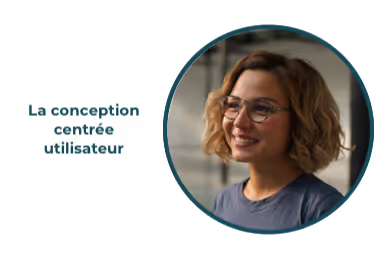
Exoskeletons represent a relevant solution to reduce the hardship and musculoskeletal disorders (MSDs) On the workstation.
Despite this, many companies are hesitant to start because this equipment is often poorly accepted by employees. Considered too bulky and uncomfortable, they do not adapt to their daily needs and end up in the closet.
What if the acceptability of equipment that is part of the user began as soon as it was designed?
In design, just because you meet a need does not mean that the product will be accepted by the user. To guarantee adherence to a product, we must consider the use that the user will make of it, this is called the user experience. Let's discover this approach together.
Understanding the user
Without considering the user, his needs and his obstacles, it is impossible to get him to adhere to a product, especially when it comes to an innovative product for which he has no reference system.
Indeed, a product cannot meet everyone's needs, each population group has different expectations and the more specific the target group is, the more common their expectations are and the simpler it will be to formalize them in order to design a product that meets them.
In the case of the Japet exoskeleton, which targets back pain, it is first essential to understand this pathology, its factors, and the psychological and physical impacts it induces.
Understanding existing solutions and analyzing how they are or are not already accepted by users makes it possible to identify which population category is already addressed and satisfied by an existing product, and especially which is not.
By targeting operators who perform activities that put strain on the back in order to avoid the incidence/recurrence of work stoppages for low back pain and to keep workers suffering from this pathology employed - the Japet.W exoskeleton targets the need of a category of users that is not already addressed by other exoskeletons for the back.
It is then a question of precisely defining the needs and expectations of this category of users by identifying with them.
Identify yourself with the user and their ecosystem.
In any new technology, it is necessary to define all the key players in the user ecosystem. Indeed, adherence to a new technology does not end with the user's mere perception of the product.
Indeed, the actors making up the user's ecosystem can have an impact on their adherence to the solution; the interactions they have with them will influence their perception and their acceptability of the product.
For example, when using in the workplace, we must take into account ergonomists, HSEs, team leaders, colleagues... who each have different interactions with the end user.
It is then necessary to identify yourself with each of these actors on:
- What he thinks and feels makes it possible to better understand his emotions, beliefs, and frustrations.
- What he hears allows us to know his influences, who he considers, and who he credits.
- What he says/does allows us to know how he acts, what are his behaviors
- What they see in existing products, and identify what they find visually familiar.
This work makes it possible to define everyone's fears and motivations, to consider the thoughts, beliefs, feelings, cognitive biases and behaviors that impact the perception of a product in order to know what levers to act on in order to promote its acceptability.
Define what can be done.
The definition phase makes it possible to understand how, for each stage of the user journey, the product can be integrated. It also makes it possible to identify which type of product to focus on.
Indeed, now that you know your target, the scenario or user journey makes it possible to identify and define, for each moment and each need, how the solution can be integrated into it.
In their design, scenarios must include all the steps for the acceptability of the product (its discovery, its understanding), its integration and its acceptance (in its use). They must call on experts in the sector and the users themselves in order to fully understand the needs of use of the product.
The detailed scenarios, taking into account environmental, human, psychological interactions, and psychological, physical, and organizational impacts, clarify what the solution should and should not include. Thus, the design of the solution will be consistent with the needs of users and users.
But before starting to design, defining the typology (or DNA of the product) makes it possible to ensure that the solution will be integrated and accepted by the user.
In the example of the Japet.W exoskeleton, we identified that the lumbar belt, an existing product, is already used and well accepted by target users.
Indeed, we know how this product acts and interacts with the user: its textile composition is easily acceptable for the user because similar to clothing, it can rely on a reference system that is already well integrated into his daily life. This material also meets the biomechanical, comfort and breathability constraints that are essential for this type of product close to the body.
Design and create.
The design activity should always be human-centered and consider the entire user experience.
Each solution design brick will be projected into the scenario in order to assess how it will interact with the user in each stage of use.
Then, the solution is confronted with reality: it is co-design. It allows direct feedback from the user and their ecosystem on what has been designed.
The objective is to obtain a conceptual response adapted to each use and user.
Prototype.
Prototyping is the conceptualization, the realization of a tangible product for the user.
There are 2 types of complementary prototypes: intent prototypes and functional prototypes.
The intention prototypes will project the user into the visual for the acceptability of the future product. On the other hand, functional prototypes will project the user into the very use of the future product.
The prototypes will be studied by the users and it is thanks to their feedback and the iteration of the prototypes that the solution will gradually become acceptable for the user and thus promote immersion in its use.
Test under real conditions of use.
Essential to the evaluation and validation of the concepts put in place, tests in real conditions or field tests are the last validation of the adequacy between the future product and its acceptability by operators.
These evaluations are not random but must follow a protocol.
It is then a question of defining the evaluation criteria:
- What you want to assess. Are we looking for an overall test of the product in the scenario or a test of a particular element of the product or in a key stage of the scenario?
- By whom we want to have tested. Should we consider the direct user but also all the players in their ecosystem?
- The test environment. What is the sector of activity of the target user but also what are the environmental constraints in this sector?
- When to do the test. How long should the test last to get relevant feedback and when should these tests be carried out?
- How to perform these tests. What are the evaluation criteria needed to obtain feedback on the areas of satisfaction, efficiency and effectiveness?
- Why do these tests. Are we trying to limit accidental, psychosocial risks, residual, physical or psychological impacts?
All these evaluation criteria are based on the fusion and balance between the factors of perception of the user (perceived usefulness), his behavioral intention, and the affordance of the product (the ability of an object to suggest its own use).
They make it possible to standardize the tests, so the feedback obtained can thus be analyzed and returned to the design. The user-centered design approach is therefore an iterative approach. This ends when the solution reaches a sufficient level of acceptability and acceptance by users.
At Japet, the iterative design process up to the acceptability of the solution, leads to the achievement of the standard related to the suitability of the product to use and regulated by the CE Medical.





